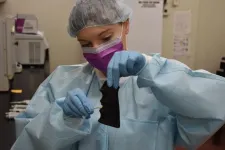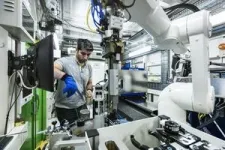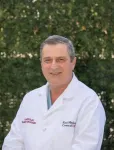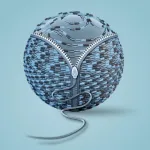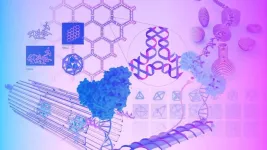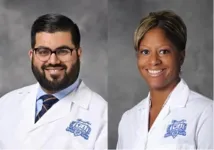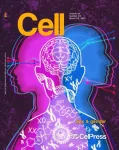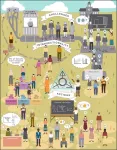(Press-News.org) DURHAM, N.H.—Television dramas, like CSI and NCIS, make criminal investigations look easy. In real life, DNA testing can be challenging and requires expensive equipment, special facilities and extensive training to identify DNA from a crime scene and determine which belongs to a potential suspect and which may have been transferred from someone who was never there. Research from the University of New Hampshire has found a less expensive and easier to use test to learn more about forensic touch DNA. This research has important implications for forensic investigations and being able to identify DNA from a primary contact—someone who may have committed the crime—as well as secondary DNA that was inadvertently and indirectly transferred through touch.
“So-called ‘touch DNA’ is a form of trace DNA that is deposited when a person touches something and leaves behind their skin cells, sweat or other fluids that contain their DNA,” said Samantha McCrane, a lecturer in anthropology and co-director of UNH’s Forensic Anthropology Identification and Recovery (FAIR) Lab. “While touch DNA is often the result of direct contact, which we call primary transfer, it can also be indirectly transferred between surfaces or individuals, leaving behind secondary or even tertiary DNA.”
In their study, recently published in the Journal of Forensic Sciences, researchers developed an innovative test that uses a more accessible and affordable sequence method, known as qPCR. To test their protocol, they paired male and female volunteers and kept it simple, only looking at one marker to determine the sex of the DNA. In the trials, they first had a male participant hold a gun grip for 30 seconds before placing it down on a sterilized table. Then, a female picked up the same gun grip and held it for 30 seconds and followed that by grasping a coffee cup for 30 seconds. Afterward, the gun grip, coffee mug and female's hand were all swabbed for DNA.
The findings with the new method found male and female DNA on the gun grip in 71% of the trials indicating primary transfer since both participants directly touched the gun grip. Male DNA was found on the female's hand in 50% of the trials representing secondary transfer since the DNA was transferred indirectly from the gun grip. Male DNA on the coffee mug was recorded 27% of time indicating tertiary, or third level, transfer since the DNA was indirectly transferred from the gun grip to the female's hand and finally to the coffee mug.
“The challenge with transfer DNA is that it opens up the dangerous possibility of DNA ending up on items or victims at a crime scene that a person may not have touched” said McCrane. “This has occurred in multiple cases, leading to innocent individuals being charged for crimes they didn't commit.”
The study also looked at the potential effects of age, ethnicity and skin conditions on DNA transfer. Ethnicity and age did not appear to affect touch DNA deposits and the small sample of those with sloughing skin conditions, like eczema, did not show any significant association with primary DNA transfer.
Researchers say even DNA experts cannot distinguish between different types of DNA transfer and this understudied field lacks enough data to fully understand which variables affect direct versus indirect DNA transfer and how often it happens. These new study results contribute to a better understanding of the conditions under which secondary and tertiary DNA transfer occurs and researchers are hopeful this new inexpensive protocol could lead to more research allowing for greater sample sizes and replication runs.
Co-author on the study was Connie Mulligan, professor of anthropology at the University of Florida.
The University of New Hampshire inspires innovation and transforms lives in our state, nation and world. More than 16,000 students from 49 states and 82 countries engage with an award-winning faculty in top-ranked programs in business, engineering, law, health and human services, liberal arts and the sciences across more than 200 programs of study. A Carnegie Classification R1 institution, UNH partners with NASA, NOAA, NSF, and NIH, and received over $210 million in competitive external funding in FY23 to further explore and define the frontiers of land, sea and space.
IMAGES FOR DOWNLOAD
Link: https://www.unh.edu/unhtoday/sites/default/files/lab2.jpg
Caption: Samantha McCrane of UNH’s Forensic Anthropology Identification and Recovery (FAIR) Lab swabs a gun grip to look for trace DNA during study trials with a less expensive and easy to use DNA test.
Photo credit: UNH
Link: https://www.unh.edu/unhtoday/sites/default/files/lab1.jpg
Caption: The handle of a gun is swabbed to search for trace DNA using a new less expensive and easy to use DNA test.
Photo credit: UNH
###
END
The first call for applications for the FRONTIERS journalist residencies closed on 5 March 2024 and attracted 33 submissions. The competition was open to any science journalist interested in a residency of three to five months at a research institution in the EU or associated country. Applications will now be evaluated by a committee composed of members of the FRONTIERS consortium and its Advisory Board.
In this first round of submissions, journalists from five continents applied for residencies at host institutions in thirteen different countries. There were applications from experienced journalists and junior ones with journalistic projects in all scientific domains.
The results ...
With the help of the ESRF, researchers from Karolinska Institutet (Sweden) have discovered the reproductive mechanism that permanently blocks polyspermy — a pathologic condition that arises when more than one sperm fuses with the egg, and which is lethal for embryo development. They also revealed the atomic architecture of the egg coat, which explains a set of genetic mutations causing infertility and it could make an impact in the development of non-hormonal contraception. The results are out in the journal Cell.
Infertility ...
Hao Yan, director of the Biodesign Center for Molecular Design and Biomimetics at Arizona State University and the Milton D. Glick Distinguished Professor within ASU’s School of Molecular Sciences, has been honored with the Humboldt Research Award by the Alexander von Humboldt-Stiftung Foundation.
This prestigious $65,000 award acknowledges Yan's extensive achievements in research and education.
"The institute is thrilled that the Humboldt Society is honoring Hao for his pathbreaking research and outstanding contributions as a mentor to young scientists,” says Joshua ...
DETROIT (March 14, 2024) – Interventional cardiologists at Henry Ford Hospital led a national multi-center clinical study, dubbed the “SAFE-MCS” study, that evaluated the safety of complex high-risk percutaneous coronary intervention (PCI) using mechanical circulatory support (MCS) and surveillance with the Early Bird® Bleed Monitoring System (EBBMS).
PCI is a non-surgical procedure used to treat the blockages in a coronary artery that opens narrowed or blocked sections of the artery, restoring blood flow to the heart.
“This study is the first ...
Increasing sea surface temperatures over the past 20 years in Mobile Bay — an estuary in the US state of Alabama — have coincided with five-fold increases in the abundance of juvenile bull sharks (Carcharhinus leucas), according to a study published in Scientific Reports.
Bull sharks are found globally in warm, shallow coastal waters in both fresh and saltwater environments. They help balance and maintain the health of coastal ecosystems by regulating prey populations. Along with great white shark (Carcharodon carcharias) and tiger shark (Galeocerdo cuvier), they are among the shark species that are most like to negatively interact with humans.
Lindsay ...
LOS ANGELES — A clinical trial from Keck Medicine of USC aims to provide a surgical solution for patients with a form of advanced pancreatic cancer previously considered inoperable.
The study will investigate if chemotherapy followed by a novel type of surgery to remove the cancer is a safe and effective option for patients with locally advanced pancreatic cancer, meaning that the cancer has not spread to other organs, but has grown into or close to nearby blood vessels that surround the pancreas.
“Usually, these types of tumors cannot be ...
Advanced killer robots are more likely to blamed for civilian deaths than military machines, new research has revealed.
The University of Essex study shows that high-tech bots will be held more responsible for fatalities in identical incidents.
Led by the Department of Psychology’s Dr Rael Dawtry it highlights the impact of autonomy and agency.
And showed people perceive robots to be more culpable if described in a more advanced way.
It is hoped the study – published in The Journal of Experimental Social Psychology ...
Inspired by the classic drinking bird toy, scientists in Hong Kong and Guangzhou, China have developed an engine that efficiently converts energy from water evaporation into electricity to power small electronics. The device produces energy outputs exceeding 100 volts—much higher than other techniques that generate electricity from water—and can operate for several days using only 100 milliliters of water as fuel, according to a study published March 14 in the journal Device.
“The drinking bird triboelectric hydrovoltaic generator offers a unique means to power small electronics in ambient ...
Cell, the flagship biology journal of Cell Press, presents a landmark issue on sex and gender in science. It includes a collection of articles on topics related to strategies for promoting gender equality in academia, enhancing rigor in the study of sex-related variables, and supporting transgender researchers. The special content, scheduled to appear online on March 14, 2024, also discusses the past, present, and future of research on sex and gender.
To mark the occasion, Cell Press’s parent company, Elsevier, is announcing updated guidelines on reporting ...
A group of 24 transgender (and/or family members of transgender) scientists describe what it’s like to be a transgender person in STEMM. In a commentary publishing on March 14 in the journal Cell, they discuss the historical origins of trans marginalization, explain how this affects trans people’s careers in science and medicine, and lay out actions that cisgender individuals and institutions can take to support trans people in STEMM.
This first-of-its-kind commentary appears in a sex and gender focus issue of Cell, covering topics such as gender equity, the history ...
